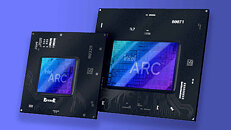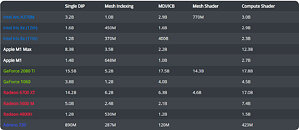- Joined
- Aug 19, 2017
- Messages
- 2,753 (1.01/day)
Intel's Arc Alchemist graphics cards launched in laptop/mobile space, and everyone is wondering just how well the first generation of discrete graphics performs in actual, GPU-accelerated workloads. Tellusim Technologies, a software company located in San Diego, has managed to get ahold of a laptop featuring an Intel Arc A370M mobile graphics card and benchmark it against other competing solutions. Instead of using Vulkan API, the team decided to use D3D12 API for tests, as the Vulkan usually produces lower results on the new 12th generation graphics. With the 30.0.101.1736 driver version, this GPU was mainly tested in the standard GPU working environment like triangles and batches. Meshlet size is set to 69/169, and the job is as big as 262K Meshlets. The total amount of geometry is 20 million vertices and 40 million triangles per frame.
Using the tests such as Single DIP (drawing 81 instances with u32 indices without going to Meshlet level), Mesh Indexing (Mesh Shader emulation), MDI/ICB (Multi-Draw Indirect or Indirect Command Buffer), Mesh Shader (Mesh Shaders rendering mode) and Compute Shader (Compute Shader rasterization), the Arc GPU produced some exciting numbers, measured in millions or billions of triangles. Below, you can see the results of these tests.


Next, we have a Ray Tracing test with Compute Shader (CS) and hardware (API) rendering models. These ones cover CS Static (ray tracing with 40M triangles total), CS Dynamic Fast (ray tracing with 4.2M triangles and 2.9M vertices total), and CS Dynamic Full (CS Dynamic Fast but with full BLAS rebuild instead of fast BVH update) tests. The API ones include API Static, API Dynamic Fast, and API Dynamic Full, using API-provided ray tracing techniques. The timings shown below represent BLAS update / Scene tracing times.

The team also tested how much memory the GPU needs for BLAS and Scratch buffers, as shown below.

Overall, the Intel Arc GPU performance is not excellent due to the poor state of the driver. Tellusim's GravityMark benchmark crashes on D3D12 API, meaning that Intel has much work to do to improve the performance. Numbers for Arc A370M are easily scaled to its bigger brother, the A770M, as the giant silicon has four times the compute power, so rough estimations could be placed.
View at TechPowerUp Main Site | Source
Using the tests such as Single DIP (drawing 81 instances with u32 indices without going to Meshlet level), Mesh Indexing (Mesh Shader emulation), MDI/ICB (Multi-Draw Indirect or Indirect Command Buffer), Mesh Shader (Mesh Shaders rendering mode) and Compute Shader (Compute Shader rasterization), the Arc GPU produced some exciting numbers, measured in millions or billions of triangles. Below, you can see the results of these tests.


Next, we have a Ray Tracing test with Compute Shader (CS) and hardware (API) rendering models. These ones cover CS Static (ray tracing with 40M triangles total), CS Dynamic Fast (ray tracing with 4.2M triangles and 2.9M vertices total), and CS Dynamic Full (CS Dynamic Fast but with full BLAS rebuild instead of fast BVH update) tests. The API ones include API Static, API Dynamic Fast, and API Dynamic Full, using API-provided ray tracing techniques. The timings shown below represent BLAS update / Scene tracing times.

The team also tested how much memory the GPU needs for BLAS and Scratch buffers, as shown below.

Overall, the Intel Arc GPU performance is not excellent due to the poor state of the driver. Tellusim's GravityMark benchmark crashes on D3D12 API, meaning that Intel has much work to do to improve the performance. Numbers for Arc A370M are easily scaled to its bigger brother, the A770M, as the giant silicon has four times the compute power, so rough estimations could be placed.
View at TechPowerUp Main Site | Source





